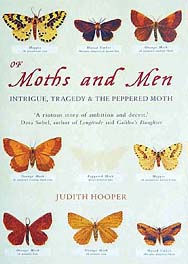|

Sunday, July 20, 2003 |
 |
Books |
 |
 |
Ambition, lust and fudged scientific data
Kamaldeep K. Toor
Of Moths and Men
by Judith Hooper. 4th Estate, London. Pages 377. `A3 8.99
 JUDITH
Hooper makes it clear at the very beginning that lepidopterists are
boring and that one cannot empathise with them unless one shares
their interests, but she weaves such a fascinating story about their
personal and professional lives that it leaves even the layman
besotted. Of Moths and Men is an account of the deceit and
fraud in scientific treatises, of how personal agony like a troubled
childhood or illness and complexes influence scientific data. It
proves that scientists are not emotionless robots but are as
susceptible to lust for wealth and fame as any other person. JUDITH
Hooper makes it clear at the very beginning that lepidopterists are
boring and that one cannot empathise with them unless one shares
their interests, but she weaves such a fascinating story about their
personal and professional lives that it leaves even the layman
besotted. Of Moths and Men is an account of the deceit and
fraud in scientific treatises, of how personal agony like a troubled
childhood or illness and complexes influence scientific data. It
proves that scientists are not emotionless robots but are as
susceptible to lust for wealth and fame as any other person.
The concept of natural
selection and industrial melanism forms the crux of the book. Darwin
in his book The Origin of Species by Means of Natural Selection
had theorised that species evolve because nature selects those
characteristics that help an individual to survive and breed. This
theory caused a furore in the scientific community in the late 19th
century but faded into obscurity in the first part of the 20th
century. The reason was that while the theory was convincing it was
practically impossible to prove until one man decided to do so. At
the heart of the story is H.B.D. Kettlewell, a British amateur moth
collector with a troubled personal life. Egging him on was the
Oxford don E.B. Ford. It was Ford who rescued Darwinism from
obscurity in the 1920s and 30s and Kettlewell absorbed his ideas. At
the heart of their scientific experiments was the peppered moth.
This night-flying moth was originally off-white in colour with a
freckling of black scales. But surprisingly, at the height of the
Industrial Revolution in the mid-19th century there
emerged a dark form of this moth in the industrialised regions.
These melanic (dark) moths began to breed and grow in large numbers
where there was a factory or the atmosphere was polluted. In the
unpolluted countryside it was the opposite. The normal off-white
variety thrived there. The implication was obvious. In the dark,
polluted industrialised regions the melanic moths had a better
chance of survival whereas in the countryside the normal pale
variety would survive. Scientists thought that this was Darwin’s
natural selection at work. For years industrial melanism as it was
called, remained a theoretical precept until Kettlewell went out
into the countryside to prove it in 1953. He went to Birmingham (an
industrial area) and Dorset (an unpolluted region) and conducted his
difficult experiments. Kettlewell proved that natural selection was
at work. He got the perfect statistical data and was the first to
prove experimentally that Darwin’s natural selection was not
merely a theory. His work found a place in high school science books
and was established as gospel truth.
|